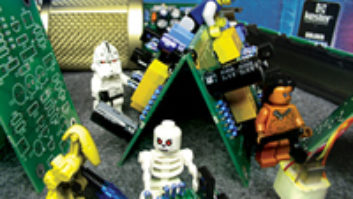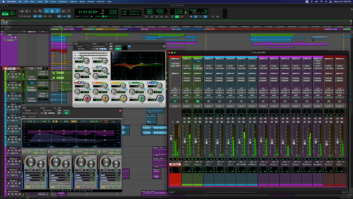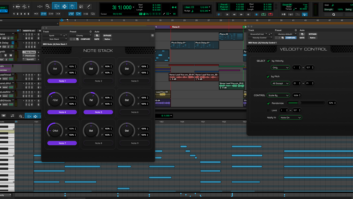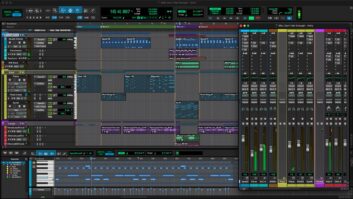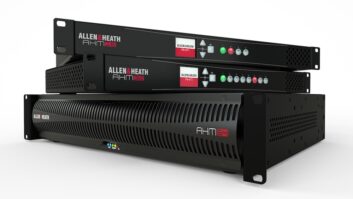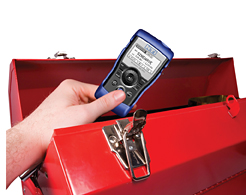
Did you ever try to be creative with an unfamiliar set of tools? Like a paintbrush, a musical instrument or recording gear, amazing things can happen when tools become an extension of mind, body and soul. I see this on a daily basis, watching electronics students learn to solder and use needle-nosed pliers.
This column will show you how to string together a necessary “audio” toolkit while working on a budget. Tools made from hardened tool-grade steel alloys (plus a little respect) will ensure that your hardware friends will have a long, productive life. For example, I’ve had a Wiha miniature screwdriver set in daily use for 15 years, and it’s still quite usable: Its steel alloy comprises a “special blend” of chrome, vanadium and molybdenum.
TURN, TURN, CAREFULLY TURN
While your tools may be made of high-quality steel, the same isn’t always true for the screws and nuts that hold your beloved gear together. Combined with the use of screw guns used in manufacturing, this leads to screws that often don’t want to be removed on the first try. If the driver slips out of a screw, the head can be damaged, making it twice as hard to get out.
Audio geeks need an almost mind-boggling range of screwdrivers — there are easily a half-dozen “standard” Phillips and flat-head sizes alone, plus Pozidrive, security bits and the various lengths needed for hard-to-get screws. With so many options, I suggest two multipurpose screwdrivers that cover the four most commonly used tip sizes: Made from S2-grade steel, Cooper Tools’ crescent SDMB7V multipurpose tool includes Number 1 and Number 2 Phillips, 3/16-inch and 9/32-inch flat (slotted) blades, plus ¼-inch, 5/16-inch and 7/16-inch nut drivers. General Tools & Instruments’ pocket driver includes 1/16-inch and ⅛-inch slotted tips, and Number 1 and Number 00 Phillips (cross-point) tips.
NEEDLE ME, PLEASE
Needle nose, long nose and even chain nose are all variants on the “electro-mechanical pliers” theme that are rarely found at a local hardware store or even at a Radio Shack. Notice that these are “just” pliers (not wire cutters), approximately 5 inches in length. The jaws are either minimally serrated (gripping grooves) or not at all. Ranging from inexpensive $4 models to better Xcelite and Klein Tools versions ($15 to $17), these are ideal for delicate electro-mechanical work, such as bending component leads and placing parts on a circuit board.
FEELING FLUSH
There are all sorts of wire and component lead cutters, and while just about anything can cut the legs off a resistor, capacitor or transistor, it’s the “flush cutter” variant of diagonal pliers that really tickles my fancy. No matter what’s being cut, flush cutters require less effort and, in the process, inflict minimal shock to delicate electronic components. Flush cutters also minimize the potential for after-the-fact pain — especially with wire ties. (Nothing is more annoying than messing with cabling with razor-sharp wire-tie ends, the result of using a special tool that stretches the tie until it breaks. In this case, faster is not better.)
The disadvantage of flush cutters is that a sharper blade is more vulnerable, which is one reason why it’s important to choose the correct tool for the job. Having experience with cheap tools is motivation enough to invest in better ones. Studer, for example, included a set of screwdrivers and hex keys that helped establish a high standard back when I was cutting my geek baby teeth. These days, European-made tools (like Erem) and test equipment (like NTI) are more expensive due to their quality and because of the poor exchange rate.
Swanstrom is a comparable U.S.-made brand. Manufacturers that feature “induction hardening” of tool-grade steel results in a cutting-edge hardness of 62HRc-65 HRc. HRx is the Rockwell Hardness Scale, where “x” refers to the type of metal under test (b for soft metals like brass and aluminum, c for hard metals). HRc 55 to HRc 65 is the range typically preferred for tools and knives. Comparable hardness for AISI (American Iron and Steel Institute) are as follows: D2 (HRc 54), M7 (HRc 63) and M42 (HRc 66).
CUTTING AWAY THE SHEATH
I confess a penchant for simple wire-stripping tools over the universal and automatic type. This is partly due to the need to understand (and teach) the behavior of various insulation types. You might laugh, but the Jedi approach of using “The Force” will explain how some “masters” manage to get so much from their tools with what seems like so little effort. Brands such as Klein, Miller and Xcelite offer quality models in the $5 to $7 range.
HEX ON U
There are many specialized tools, but a set of hex keys (which are also known by the trade name Allen Wrenches) is essential. Other “keyed” variations include Torx, Robertson (square), Tri-Wing, Torq-Set, Spanner Head and Triple Square. To my surprise, the Bondhus hex-key brand is made here in Minnesota. The company’s Website (www.bondhus.com) includes a simplified metallurgy overview that’s worth perusing.
ELECTRONIC FRIENDS
Here are the tools I use every day. A multimeter typically measures volts, ohms and milliamps. The Fluke 8060A also measures dB and frequency (in the audio range). I also have several “lesser” analog and digital meters; the latter do “other” interesting things like measure capacitance, inductance and transistor beta (Hfe).
A cheap oscillator, like the $60 Tenma 72-505, is great for the price. With sine distortion below 0.03 percent, a square-wave function and the ability to output +4 dBm, it does most of what you’ll need at a very affordable price. The NTI Minirator MR-PRO handles more-demanding applications that require lower distortion (0.0016), precise level control from -80 dBu to +18 dBu, and numerous other cool features you’ll have to go online to check out.
Similarly, NTI’s Minirator MR-1 has an article’s worth of features, but does two things in particular that are very helpful when working on vintage gear: It measures distortion and provides spectrum analysis. Because distortion measurements automatically include “noise,” it’s nice to be able to see where the noise is coming from (typically from power supply and grounding issues). An oscilloscope is also an essential tool; an entry-level, 20MHz dual-trace ‘scope can be had for less than $300.
NEW OR USED?
All tools will suffer from normal wear and tear, but well-made tools can be brought back to near-new quality with a little TLC (and a knowledge of sharpening and polishing techniques). I once found a dozen high-quality, used long-nose pliers for $2 each. A little gentle grinding, filing, sanding and polishing, and they were nearly good as new.
SO WHAT ELSE WILL YOU NEED?
As you get more involved in electronic maintenance, repair and modification, you’ll find lots of useful doo-dads for your collection. One classic is a “helping hands,” a weighted base with pivoting arms and adjustable alligator clips that hold wire/component/connectors in place while you solder — a great item that’s widely available for less than $10. A cable tester is another simple time/effort-saver. Not only is it easier to deal with than a VOM meter, but with both ends attached to the tester, you can bend the cable around to check for shorts or intermittent connections.
We’ll have some more toolbox fun in upcoming issues, but in the meantime, keep your mind and (non-electronic) tools sharp and lightly oiled.
For more geek speak, visit Eddie Ciletti online at www.tangible-technology.com.
A Few Online Tool Sources
Digikey
www.digikey.com
Dynamite Tools
www.dynamitetoolco.com
Electronix Express
www.elexp.com
HMC Electronics
www.hmcelectronics.com
MCM Electronics
www.mcmelectronics.com
Mouser Electronics
www.mouser.com
Parts Express
www.partsexpress.com
Pro’sKit
www.proskit.com
